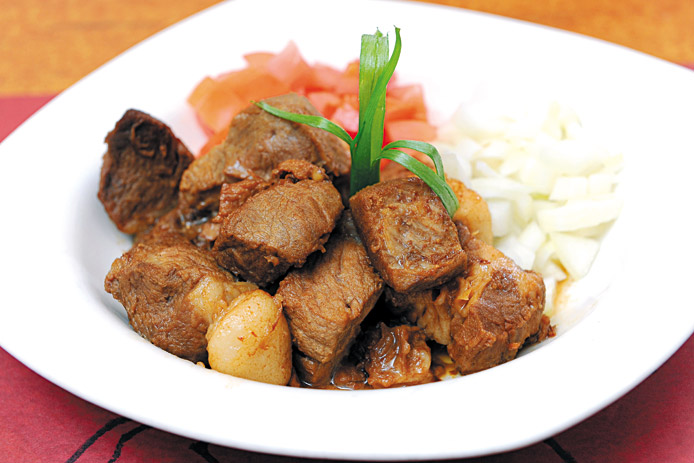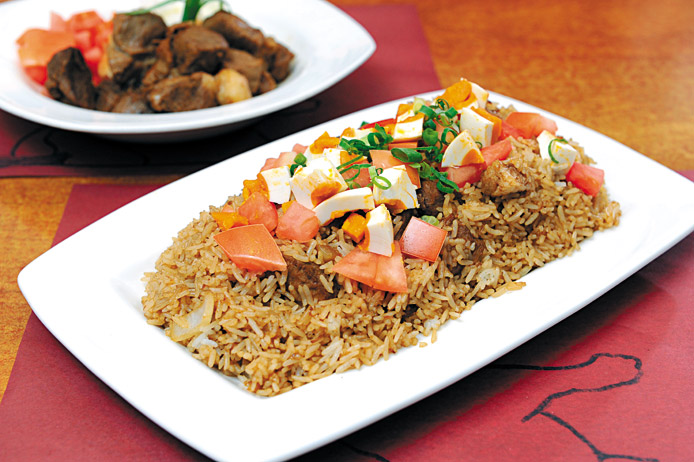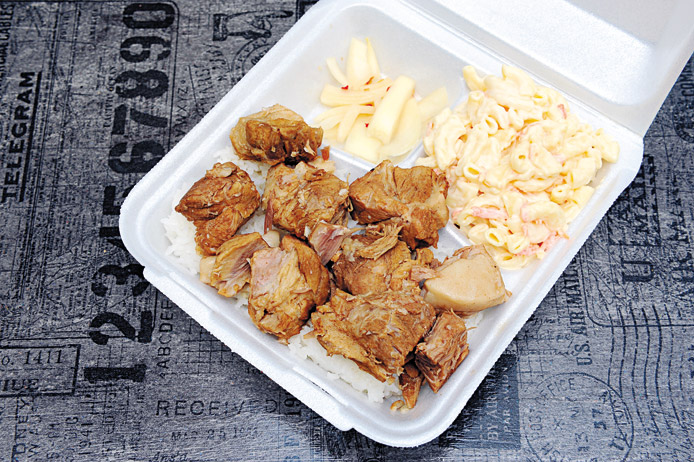
Dining Out editor Ellise Kakazu is ready to dig into Max’s of Manila’s flavorful Pinatuyong Pork Adobo ($11.95).
What do Manny Pacquiao, current Miss Universe Catriona Gray and adobo have in common? They are all huge stars of the Philippines!
Consisting of more than 7,000 islands, it is no wonder the Southeast Asian country is home to many notable people and things like adobo, a traditional Filipino dish. Adobo, which is often considered the unofficial “official” dish of the Philippines, typically consists of chicken or pork flavored with vinegar, garlic, soy sauce, peppercorns and bay leaves.
The dish’s tantalizingly tangy taste has helped the native creation rise to stardom across the globe, landing on many mom-and-pop and even upscale restaurants’ menus.
Being a proud adobo fangirl, I happen to know quite a few places serving up masarap (delicious in Filipino) plates of it right here in Hawaii.
So, bust out the largest utensils you can find and get ready for some gigantic waves of flavor!
SPREADING CULTURE THROUGH FOOD
It is safe to say Max’s of Manila has taken the world by storm with its authentic Filipino fare. Max’s currently has more than one hundred locations spanning the Philippines and many others across the globe, including Canada, the Middle East and Oahu.
Offering dishes like Lechon Kawali, Kare-Kare and Daing na Bangus, the popular restaurant provides customers the opportunity to try an array of native dishes at an affordable price.
According to general manager Maly San Luis, Max’s of Manila’s goal is to provide meals that will either introduce or reconnect customers to the Filipino culture.
A native dish that easily fulfills the restaurant’s mission is Pinatuyong Pork Adobo ($11.95), a staple of the Philippines. San Luis explains the chunks of pork are braised for about an hour in a mixture of soy sauce, vinegar, bay leaves and black peppercorns to intensify the meat’s flavor, and are served alongside freshly chopped tomatoes and onions.
“(Adobo is) like step one introduction into Filipino food,” notes San Luis.
Customers wanting to try adobo in a less traditional manner can now opt for Adobo Fried Rice ($11.50).
This divine pile of rice is mixed with pieces of pork adobo, topped with chunks of salted duck egg and tomatoes, and sprinkled with green onions.
San Luis explains Adobo Fried Rice was introduced late last year as a holiday special, but due to popular demand, it is now being added to Max’s permanent menu.
WORTH EVERY ‘PENNY’
Feeding hungry kamaaina for more than 40 years, Penny’s Drive In dishes out timeless local classics, such as beef stew, shoyu chicken, chicken katsu and this week’s star, Pork Adobo ($9.50 small, $10.70 large).
According to chef and manager Sam Vance, the eatery’s Pork Adobo is flavored with diced garlic, Hawaiian salt, black pepper, bay leaves, vinegar and soy sauce. Vance also notes the recipe comes from his mother Virginia, who is also the founder of Penny’s Drive In. “It’s an old recipe,” he adds.
A plate of adobo comes with a scoop of rice, mac salad and Penny’s signature pickled onions, which are made by combining water, vinegar, chili pepper, bay leaf and Hawaiian salt.
Those wanting to get a taste of Penny’s pork adobo for breakfast are in luck, as an order of Adobo Fried Rice Omelet ($5.75), available from 5 to 10 a.m., features the tangy pork tossed with luncheon meat, char siu, onions, bacon, soy sauce and rice.
Besides adobo, Vance encourages customers to try one of the eatery’s roasts (Roast Beef or Pork) offered on its lunch menu.
“That’s the first thing that goes,” he notes. As they say, “the early bird gets the worm,” so head on over to Penny’s Drive In before it’s too late — the restaurant is open Monday-Friday from 5 a.m. to 2:30 p.m.
It looks like the curtains are closing on this adobo tour, which means it’s time to get out of your seat and find your very own plate of vinegary, flavor-packed meat to enjoy.
See you next week, my Dining Out friends!
See more articles from: Max's of Manila, Penny's Drive In




